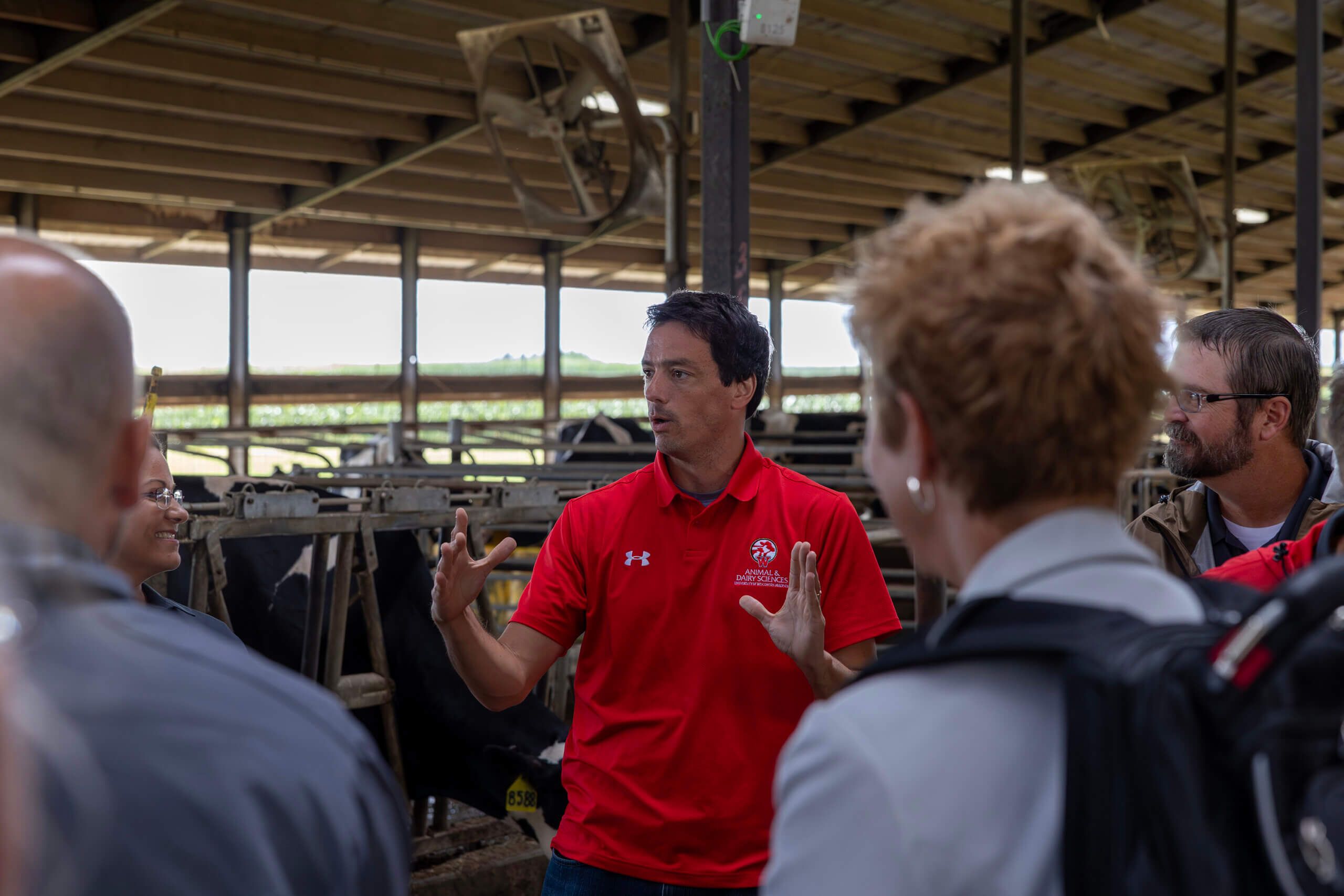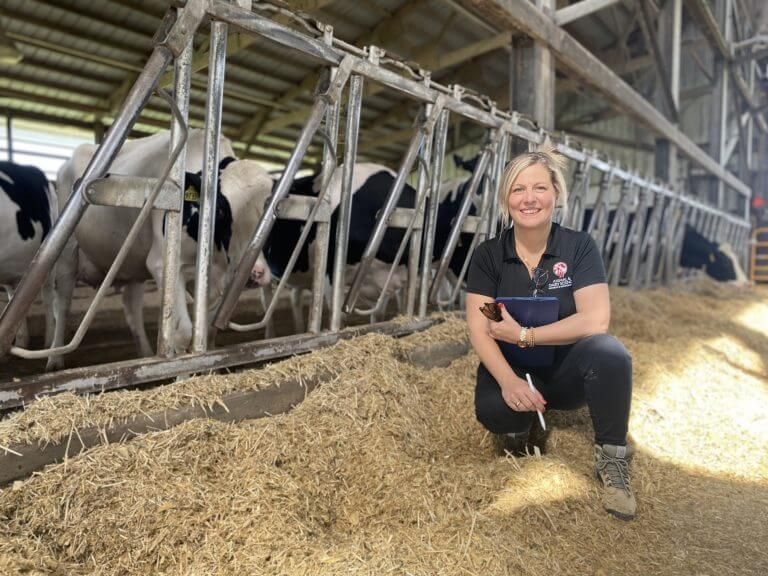If you’ve followed Observatory Drive out to a butcher block–shaped building with a cleaver-sleek design, you’ve arrived at the next frontier in meat science and research: UW–Madison’s Meat Science and Animal Biologics Discovery building. According to Professor Jeff Sindelar of the UW’s Food Research Institute, the building, which opened in November 2020, offers heightened ceilings — both literally and figuratively — to the meat sciences program. “It’s like buying a brand-new car and getting every option available and then some,” Sindelar says. “It allows us to do things that we simply couldn’t do before because we didn’t have the technology or the space or the ability to do so.” Among those new possibilities is research in animal biologics — the ways in which molecules from animal tissue can have pharmaceutical or therapeutic applications. The building also houses Bucky’s Varsity Meats, a retail store whose product is processed on-site and which is staffed by meat science students and experts who serve as science-based resources for curious customers. Here, Sindelar offers some guidance to consumers heading to the meat market.
How to decide between buying from the grocery store, butcher, or farmer’s market:
Be cost conscious: The local grocery store typically [carries] a lot of commodity products, those that are produced in higher volumes, which provides more uniform products and usually at cheaper prices.
Ask the experts: At the small meat processor, you generally will find less in consistency and, typically, a little more expensive product. What you’re getting is an expert to ask questions or advice: you’re paying for a consultant through the upcharge for the cost of the products. You have more of a connection with your food because processors may purchase products that come from a commodity market and then do things that eventually become sellable to you and they could tell you that path, or they may buy animals from local farmers, so you may be able to purchase products and know the exact origin of where the animal’s raised.
Consider local sources: The benefit of buying at a farmers’ market is that you most certainly know where the meat came from because farmers’ markets are generally supported by local producers, so they have the most information about the animal: what it ate, how it was treated. But, you are generally paying more of a premium again because of volume. It’s more expensive to process a smaller [number] of animals.
Whether you’re supporting local businesses or buying in bulk from a grocery chain, meat sold at any of these locations is held to the same food safety standards. According to Sindelar, the consumers who reap the most benefit are those who buy from all three types of merchants and take advantage of the unique services they offer.
How to safely store, handle, and prepare meat:
Keep it cold: When an animal is harvested and processed, that muscle becomes converted to meat. That meat’s interest and intent is to go back to carbon: to break down into the components which it was to complete the life cycle. When we have meat, we’re just trying to lengthen that life cycle by proper refrigeration and proper freezing. Bacteria start to cause off flavors and off colors and off aromas at any temperature above freezing, but as the temperature increases above freezing, those things happen faster. The colder you can keep it can really impact the length of the shelf life.
Know the signs: When you have meat in your refrigerator, if you start seeing the color changing other than red — usually to a brownish color — that is a very good indication that you should cook it and consume it as soon as possible, in the next 12 to 24 hours. If you start smelling some off aromas or start seeing a little bit of sliminess, those are all indications that you should use that meat [soon]. It shouldn’t be an, “I’m going to pull the fire alarm and throw it away,” but a, “Yeah, these are signs that the meat is starting to go past its shelf life.”
Play it safe: All consumers should know that not every piece of meat has harmful bacteria, but we treat everything as if all of it does. That allows us to take a very conservative approach to food safety and try to make sure that everyone is safe while eating meat. The good news is that the bacteria that cause harmful illnesses don’t grow very well in refrigeration, so as long as you keep the meat below 40 degrees, those harmful bacteria won’t grow [as quickly].
Wash those hands (and pans): Wash your hands, and when cutting meat or using cutting boards or mixing bowls, be very conscientious to isolate those tools for working only with meat. If you need to use them for something else, wash them out in between. Follow good cooking procedures to make sure that if there are any harmful bacteria, you are cooking them to a high enough temperature to kill them. Then, when you’re done with the whole eating experience, get [leftovers] cooled down as soon as possible so that those bacteria, if they happen to be there, can’t continue to grow to levels to make people potentially ill.
Meat gets a bad rap. As a biological foodstuff, it’s natural for meat to host biological organisms such as bacteria, but it’s no different from the bacteria found in other environments, or, when harmful, from the bacteria that’s harmful in other products, such as produce and dairy, Sindelar says. His number one tip for preparing meat (besides keeping things clean): “Don’t be scared of it. Embrace it.”
How to avoid common meat-market mistakes:
Be willing to ask questions: You go into a grocery store, and there’s an array of all these different cuts and species. Consumers, including me sometimes, get a little overwhelmed. [You think,] “I just came here to make something for dinner, and now I’m faced with 150 choices, and I’m not even sure if I can narrow it down to 10!” Reaching out for help, I think, would be super valuable and really help [consumers] with more opportunities for great eating experiences.
Don’t fear fat: Leanness is okay, but there’s this trade-off because when you get too lean of a product, usually, the eating quality suffers. I like to tell people that fat is flavor. If you take all the fat out of any piece of meat, you won’t have something that’s very flavorful. That’s why pork tastes different than beef versus poultry versus venison and so forth: it’s the fat that drives that. Instead, think about volume of consumption: consuming something moderate in fat in moderation generally provides a whole lot better eating experience than consuming a higher volume of a lower-fat product.
Know your labels: There’s been a big move in the industry for several years now about clean labeling: having [only] things on the label that would be in your parents’ cupboards, [and if there are additives], it’s probably not good for you or safe. That just really, really isn’t so. I think consumers should try not to let outside influence concern them, because these products are produced under very strict USDA and FDA supervision. Every single ingredient that’s added to a meat product, including water, has to be approved by the FDA. Those ingredients and processes and products are designed to ensure that there’s no deleterious effect on the consuming public.










